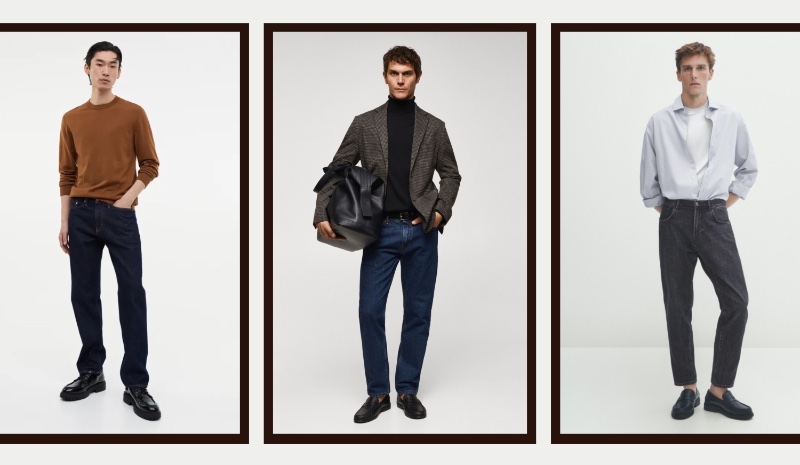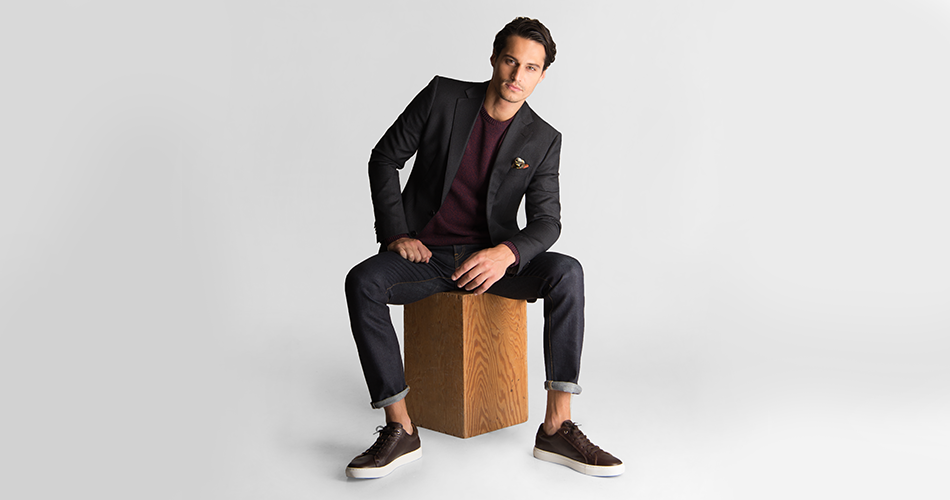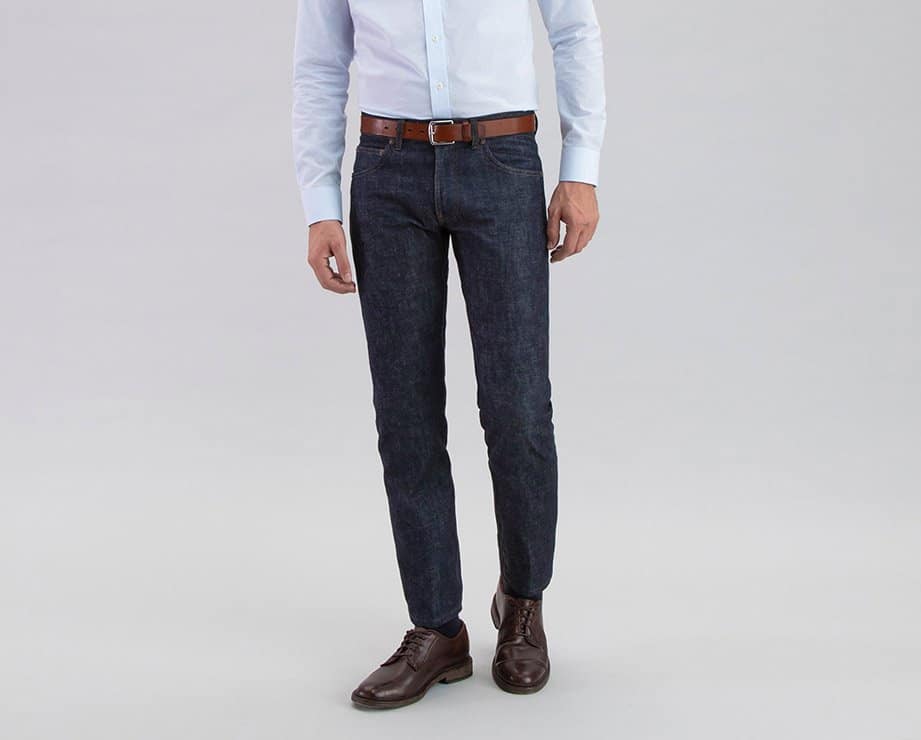Can black jeans be business casual? The answer, surprisingly, isn’t a simple yes or no. Navigating the murky waters of business casual dress codes often requires a nuanced understanding of workplace culture, industry norms, and the specific cut and quality of your clothing. This guide explores the complexities of wearing black jeans in a business casual setting, offering insights into acceptable styles, appropriate contexts, and stylish alternatives.
We’ll delve into the definition of business casual itself, examining how it varies across different industries and geographic locations. We’ll then dissect the world of black jeans, analyzing fabric weights, washes, and detailing to determine which styles are suitable for a professional environment. Finally, we’ll provide practical advice on building appropriate outfits and suggest alternatives if black jeans aren’t the right choice for your workplace.
Defining “Business Casual”

Business casual is a dress code that strikes a balance between professional and relaxed attire. It aims to project a competent and approachable image while allowing for a degree of comfort and individuality. However, the specifics of business casual can vary significantly depending on several factors, making it crucial to understand the context in which it’s applied.
Business casual attire is not a universally defined concept; its interpretation depends heavily on industry, company culture, and even geographic location. While some organizations may embrace a more relaxed approach, others maintain a stricter interpretation, closer to traditional business professional. Understanding these nuances is key to navigating the complexities of business casual dress.
Variations in Business Casual Across Industries
The interpretation of business casual differs greatly across various sectors. In creative industries like advertising or design, business casual might include more expressive clothing choices, such as stylish jeans (provided they are in good condition and appropriately styled), colorful shirts, and less formal footwear. Conversely, in more conservative fields like finance or law, business casual typically leans closer to business professional, often involving khakis or dress pants, button-down shirts, and polished shoes. Tech companies often have the most relaxed interpretations, sometimes allowing for t-shirts and jeans, while healthcare settings usually prioritize clean, neat attire and often require closed-toe shoes for safety reasons.
Impact of Company Culture and Geographic Location
Company culture plays a pivotal role in defining the acceptable boundaries of business casual. A startup with a casual and collaborative environment may have a much more relaxed dress code than a long-established corporation with a more traditional structure. Similarly, geographic location can influence attire. What’s considered business casual in a warm, coastal city might differ from what’s appropriate in a colder, more conservative region. For example, a lightweight linen shirt might be acceptable in Miami, but a heavier sweater might be necessary in Chicago during the winter, even within the same business casual framework.
Levels of Formality in Business Attire
The following table illustrates the spectrum of formality in business attire, highlighting acceptable and unacceptable garments for each level. Note that these are general guidelines, and individual company policies should always take precedence.
| Level of Formality | Acceptable Garments | Unacceptable Garments |
|---|---|---|
| Business Professional | Suit (pantsuit or suit), dress shirt, tie (for men), dress shoes, hosiery | Jeans, t-shirts, sneakers, sandals, overly casual accessories |
| Business Casual | Khakis or dress pants, button-down shirt or blouse, blazer (optional), loafers or dress shoes, dressy flats | Ripped jeans, graphic tees, flip-flops, athletic wear, overly revealing clothing |
| Smart Casual | Dark-wash jeans (in good condition), collared shirt or polo shirt, sweater, clean sneakers or loafers | Sweatpants, pajama-like clothing, excessively worn or stained clothing, inappropriate slogans |
| Casual | T-shirts, jeans, comfortable pants, sneakers | Generally, anything inappropriate for a professional setting, including clothing with offensive slogans or imagery. |
Examining Black Jeans

Black jeans, a staple in many wardrobes, present a unique challenge in the business casual context. Their versatility depends heavily on the specific style, cut, and overall quality. Understanding these nuances is key to determining their appropriateness for a professional yet relaxed environment.
Black jeans vary significantly in style, cut, and fabric characteristics, influencing their suitability for business casual settings. These differences impact not only their appearance but also their perceived level of formality.
Black Jean Styles and Cuts
Several factors contribute to the overall look of black jeans. The cut can range from skinny jeans, characterized by their tight fit from hip to ankle, to straight-leg jeans, offering a more classic and less form-fitting silhouette. Bootcut jeans flare slightly at the ankle, while relaxed-fit or boyfriend jeans offer a looser, more comfortable fit. The weight of the denim also plays a crucial role; heavier denim, often used in selvedge jeans, generally appears more substantial and formal than lighter-weight denim commonly found in stretch jeans. The wash of the jeans also impacts the overall appearance; dark, unwashed black jeans tend to project a more professional image than heavily distressed or faded black jeans. Finally, details like visible stitching, embellishments, or excessive distressing can significantly detract from a professional look.
Examples of Appropriate and Inappropriate Black Jeans for Business Casual
Appropriate choices for business casual settings might include a well-fitting pair of dark wash, straight-leg or slightly tapered black jeans made from heavier-weight denim. These jeans, free from embellishments and distressing, project a more polished and sophisticated appearance. Conversely, excessively distressed jeans, those with rips, tears, or significant fading, are generally unsuitable. Similarly, skinny jeans, while fashionable, might be considered too casual for some business casual environments, especially when paired with less formal tops. Light-wash black jeans, or those with a noticeable stretch component that might appear too casual, are also best avoided.
The Impact of Fabric Quality on Perceived Professionalism
The quality of the denim significantly impacts the perceived professionalism of black jeans. High-quality denim, typically made from durable, tightly woven cotton, hangs better, drapes more smoothly, and generally appears more refined than lower-quality denim, which might look cheap, stiff, or prone to wrinkling. The presence of elastane or spandex can contribute to comfort but might also reduce the perceived formality, depending on the percentage and the overall drape of the fabric. Investing in well-made, durable black jeans from reputable brands often translates to a more professional appearance.
Accessories that Elevate or Detract from Professionalism
The right accessories can elevate the look of black jeans, while the wrong ones can easily undermine the effort.
- Elevating Accessories: A tailored blazer, a crisp button-down shirt, a structured handbag, and polished leather shoes (loafers, oxfords, or ankle boots) all contribute to a professional business casual appearance when paired with black jeans.
- Detracting Accessories: Conversely, sneakers, overly casual tops (graphic tees, hoodies), brightly colored or overly embellished belts, and excessively large or flashy jewelry can make the overall look too informal for a business casual setting.
Contextual Factors
The acceptability of black jeans in a business casual setting hinges significantly on contextual factors. These factors extend beyond simply the garment itself and encompass the specific workplace environment, the individual’s role, and the overall presentation of their outfit. A nuanced understanding of these factors is crucial for making informed decisions about professional attire.
The appropriateness of black jeans varies greatly depending on the company culture and industry.
Workplace Scenarios and Black Jeans Appropriateness
The suitability of black jeans in a business casual environment is highly dependent on the specific context. Consideration should be given to the company culture, the individual’s role, and the overall outfit. The following table illustrates various hypothetical workplace scenarios and whether black jeans would be considered appropriate.
| Scenario | Industry | Role | Black Jeans Appropriate? |
|---|---|---|---|
| Meeting with a potential client at a tech startup | Technology | Junior Developer | Yes, paired with a crisp button-down shirt and clean sneakers. |
| Presenting a project to senior management at a marketing agency | Marketing | Senior Account Manager | Possibly, depending on the agency’s culture. A blazer and polished loafers would elevate the look. |
| Attending a court hearing at a law firm | Legal | Paralegal | No, professional attire such as a suit is expected in such a formal setting. |
| Friday afternoon team meeting at a design firm | Design | Graphic Designer | Likely acceptable, provided the jeans are well-fitting and paired with a stylish top and appropriate footwear. |
Industry Variations in Business Casual Dress Codes
Different industries have vastly different interpretations of business casual. A tech startup, known for its relaxed and innovative culture, might readily accept black jeans, especially if paired with a stylish shirt and blazer. In contrast, a law firm or financial institution, where tradition and formality are often prioritized, would likely consider black jeans inappropriate, even in a business casual context. The conservative nature of these industries necessitates more traditional attire. The acceptance of black jeans often correlates with the level of creativity and informality associated with a particular industry.
The Importance of the Overall Outfit
Even in environments where black jeans might be considered acceptable, the overall outfit is paramount. The key is to create a balanced and polished look. Pairing black jeans with a wrinkled t-shirt and worn-out sneakers will project a far different image than pairing them with a well-fitting blazer, a crisp button-down shirt, and polished shoes. Accessories, such as a watch or belt, can also contribute to a more professional appearance. The overall goal is to maintain a professional image while still embracing a degree of comfort and style.
Alternatives to Black Jeans

While black jeans can sometimes blur the lines in business casual settings, several more appropriate alternatives offer a polished and professional look. Choosing the right bottom depends on the specific workplace culture and the level of formality required. The following explores viable options and provides guidance for making informed choices.
Trousers as Business Casual Bottoms
Trousers, particularly those in wool, cotton twill, or gabardine, represent a classic and versatile option for business casual attire. Unlike jeans, their structured fabric and tailored fit convey professionalism. Wool trousers, for instance, offer warmth and a sophisticated appearance, suitable for colder climates or more formal business casual environments. Cotton twill trousers provide a more breathable and slightly less formal option, ideal for warmer weather. Gabardine, known for its durability and smooth texture, strikes a balance between formality and comfort.
Compared to black jeans, trousers generally offer a more polished and professional aesthetic. However, they can be less comfortable for extended periods and might require more care and maintenance. The cost is also often higher than a pair of black jeans.
Chinos as a Business Casual Option
Chinos, made from cotton twill or similar fabrics, offer a comfortable yet refined alternative to jeans. Their versatility allows for various styles, from slim-fit to straight-leg, making them suitable for diverse body types and preferences. Chinos are generally more wrinkle-resistant than trousers, offering practicality for those with busy schedules. However, their lighter weight and less structured appearance may make them less suitable for extremely formal business casual environments.
In comparison to black jeans, chinos offer a more polished appearance while maintaining a level of comfort. They are generally more breathable than trousers, making them suitable for warmer climates. The cost is typically moderate.
Skirts as a Business Casual Bottom
For women, skirts provide a stylish and professional alternative to jeans. Pencil skirts, A-line skirts, or wrap skirts in fabrics like wool crepe, cotton twill, or even a structured jersey can all be appropriate for business casual settings. The length and style should be chosen based on workplace culture and personal preference, ensuring the skirt is appropriately modest and professional. However, skirts may not be as comfortable or practical as trousers or chinos for some individuals, especially those with limited mobility.
Compared to black jeans, skirts offer a more feminine and potentially more formal appearance. However, they may be less practical for some individuals and might require more consideration in terms of length and style appropriateness for the workplace.
Style Guide for Selecting Appropriate Bottoms
Choosing the right bottoms for business casual attire requires careful consideration of fabric, fit, and color.
- Fabric: Opt for high-quality, durable fabrics such as wool, cotton twill, gabardine, or linen blends. Avoid fabrics that are overly casual, like denim or excessively thin materials that may wrinkle easily.
- Fit: Choose a fit that is flattering and professional. Avoid overly tight or baggy fits. A well-tailored fit enhances the overall appearance and conveys professionalism.
- Color: Neutral colors such as navy, charcoal gray, khaki, or olive green are generally preferred for business casual settings. Black can work, but other colors offer more versatility. Avoid bright or flashy colors.
- Condition: Ensure the bottoms are clean, wrinkle-free, and in good repair. This conveys professionalism and attention to detail.
Different fabrics and fits significantly influence the level of formality. For instance, well-tailored wool trousers in a dark neutral color project a higher level of formality than relaxed-fit chinos in a lighter color. A structured pencil skirt in a solid dark color will be more formal than a flowy A-line skirt in a print.
Visual Representation of Appropriate Outfits: Can Black Jeans Be Business Casual
Successfully integrating black jeans into a business casual wardrobe requires careful consideration of the overall outfit. The key is to balance the casualness of the jeans with more formal pieces to create a polished and professional look. The following examples illustrate how this can be achieved.
Three Appropriate Business Casual Outfits with Black Jeans
The following Artikels three distinct business casual outfits incorporating black jeans, demonstrating the versatility of this garment when styled correctly. Each outfit demonstrates a different approach to achieving a professional yet relaxed aesthetic.
- Outfit 1: Smart Casual: Dark wash black jeans, a crisp white button-down shirt (long or short-sleeved, depending on the climate), a fitted navy blazer, and brown leather loafers. The blazer elevates the jeans, while the white shirt adds a touch of formality. The brown loafers provide a sophisticated and polished finish, avoiding overly casual footwear choices. This combination offers a clean, professional look suitable for many business casual environments.
- Outfit 2: Polished & Modern: Black skinny jeans (not overly tight), a fitted black turtleneck sweater, a long, neutral-colored cardigan (grey or beige), and ankle boots with a small heel. This outfit leans towards a more modern aesthetic. The turtleneck adds a sleek and sophisticated touch, while the cardigan provides warmth and texture. The ankle boots offer a stylish alternative to loafers, maintaining professionalism without being overly dressy.
- Outfit 3: Relaxed Professional: Black straight-leg jeans, a chambray shirt (a lighter, more casual alternative to a button-down), a structured taupe-colored blazer, and oxfords or Chelsea boots. The chambray shirt introduces a touch of casualness, but the blazer and structured footwear maintain the professional element. This option is ideal for less formal business casual settings, offering a balance between comfort and professionalism.
An Inappropriate Business Casual Outfit with Black Jeans, Can black jeans be business casual
An example of an inappropriate business casual outfit featuring black jeans would include ripped or distressed black jeans, a graphic tee shirt, and sneakers. The distressed jeans are too casual for a business setting, while the graphic tee shirt lacks the sophistication required. Sneakers, while comfortable, are generally considered too informal for most business casual environments. This combination presents a look that is far too relaxed and lacks the polished appearance expected in a professional context. The overall impression is one of carelessness and a lack of attention to detail.
Visual Impact of Well-Fitting vs. Poorly-Fitting Black Jeans
The fit of black jeans significantly impacts their appropriateness in a business casual setting. Well-fitting black jeans, regardless of the specific style (straight-leg, skinny, or bootcut), will sit comfortably without being too tight or too loose. They will follow the natural lines of the body, creating a streamlined silhouette. Poorly-fitting jeans, conversely, can appear sloppy and unprofessional. Jeans that are too tight will cling to the body, emphasizing any imperfections and looking unkempt. Conversely, jeans that are too loose will create a baggy, unflattering appearance, detracting from the overall look and suggesting a lack of care in presentation. The difference is striking: well-fitting jeans contribute to a polished and put-together appearance, while poorly-fitting jeans detract from the overall professional image.






